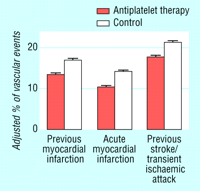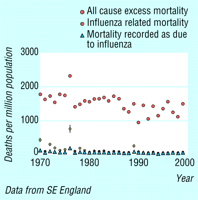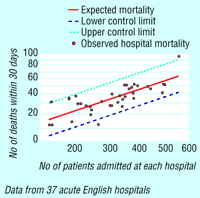This week in the BMJ
Volume 324, Number 7329, Issue of 12 Jan 2002Aspirin benefits most patients at high risk of vascular events
Effectiveness and safety of aspirin may be overrated
Single session intervention does not make smokers quit after myocardial infarction
Flu is not to blame for excess winter mortality
Giving patients more information reduces antibiotic use
Overcoming the problems of performance league tables
Costs of cannabis controls may outweigh the benefits
Cost effectiveness in screening for Down's syndrome still unclear
Mixed response to whether NHS patients should pay extra for their care
Aspirin benefits most patients at high risk of vascular events
Antiplatelet therapy with aspirin is beneficial for patients having
acute ischaemic events or arterial procedures and for long term
maintenance of people with a history of such events or with
intermittent claudication, stable angina, or atrial fibrillation. This
is the conclusion of an updated collaborative meta-analysis of all
randomised trials assessing the effects of antiplatelet therapy on
serious vascular events (non-fatal myocardial infarction, non-fatal
stroke, or vascular death) by the Antithrombotic Trialists' Collaboration (p 71). The study also showed that for patients requiring prolonged antiplatelet therapy, daily doses of aspirin within
the range 75-150 mg are as effective as, but less gastrotoxic than,
higher doses. Clopidogrel is an effective alternative for patients who
cannot tolerate aspirin. In some clinical circumstances, adding a
second antiplatelet drug to aspirin seems to provide additional
protection.

Effectiveness and safety of aspirin may be overrated
Despite the vast size of the aspirin meta-analysis in this week's
issue, Cleland (p 103) states that the effectiveness and the safety of
aspirin have been overrated. He argues that aspirin may change the way
vascular events present, rather than prevent them, and that this may
lead to a "cosmetic" reduction in non-fatal events and an increase
in sudden death. Data on safety and cost-benefit of aspirin are
inadequate, and advocating the use of aspirin for preventing
atherosclerotic events diverts attention from other, more effective,
drugs such as ACE inhibitors,  blockers, and statins.
blockers, and statins.
Single session intervention does not make smokers quit after myocardial infarction
A one session bedside intervention by cardiac rehabilitation nurses
does not lead to an increase in the number of smokers who manage to
give up smoking after myocardial infarction or cardiac bypass surgery.
In a large randomised study, Hajek and colleagues (p 87) found that
nearly two thirds of patients who had seemed motivated to give up had
started smoking again by 12 months after discharge, whether they had
received the intervention or not.
Flu is not to blame for excess winter mortality
Cold weather rather than influenza is to blame for excess mortality and
demands on health services in winter. Of 1265 annual excess winter
deaths per million over the past 10 years, only 2.4% were due to
influenza. Donaldson and Keatinge (p 89) say that with influenza
causing such a small proportion of excess winter deaths, measures to
reduce cold stress offer the greatest opportunities to reduce current
levels of winter mortality.

Giving patients more information reduces antibiotic use
The amount of antibiotics used in general practice can be reduced if
general practitioners share their uncertainty over the necessity for
antibiotics with patients who present with acute bronchitis. Macfarlane
and colleagues (p 91) found they could reduce the number of patients
who took antibiotics by nearly a quarter among patients who the general
practitioner thought did not definitely need antibiotics. This strategy
could save about 750 000 courses of antibiotic nationally each year.
Overcoming the problems of performance league tables
NHS performance league tables are misleading and should be replaced by
a more user friendly method of assessing health service performance.
Adab and colleagues (p 95) suggest that control charts, used for
monitoring and controlling variation in the manufacturing industry,
would have the dual advantage of being less threatening to providers of
health services and would be more easily understood and correctly
interpreted by patients, auditors, and commissioners of services.

Costs of cannabis controls may outweigh the benefits
Current debates on cannabis policy are dominated by the potential
health costs of the use of cannabis. Wodak and colleagues (p 105)
argue that the social, economic, and moral costs of cannabis control
far outweigh the health costs of cannabis use. However, in the other
half of the debate, Drummond (p 107) argues that reducing police and
court time through decriminalisation is likely to be at the risk of
public health. He advocates better public education on the risks of
cannabis and greater availability of treatment for those
affected.

Cost effectiveness in screening for Down's syndrome still unclear
The quadruple test in screening for Down's syndrome entails
automated laboratory techniques and so may prove effective even though
there may be increased cost. In response to our research paper by
Gilbert and colleagues (BMJ 25 August), Whittle
(p 111) concludes that the challenge is to find a technique that is
cost effective and feasible to implement nationally. Reynolds (p 111) states that the detection rates for nuchal tranclucency are grossly overestimated and that the integrated test is expensive and unproved. Howe (p 112) adds that modelling does not predict reality accurately and that properly gathered clinical evidence should be used instead, and Sachdev and colleagues (p 112) suggest that in developing countries it is more appropriate to consider the ratio of femoral to
tibial length than maternal age. Venn-Treloar (p 110) highlights that
the human costs must not be overlooked.

Mixed response to whether NHS patients should pay extra for their care
"Active" patients, wealthy enough to purchase expensive drugs
such as Herceptin (trastuzumab), could add a new unbalancing component
to shared decision making. In response to the education and debate
article by Richards and colleagues (BMJ 9 September) Thornton (p 110) adds that clinicians may be rendered no more than
technicians. However, Kilcoyne (p 110) thinks that additional patient
charges are a good thing as they may help the public to start valuing
medical services.